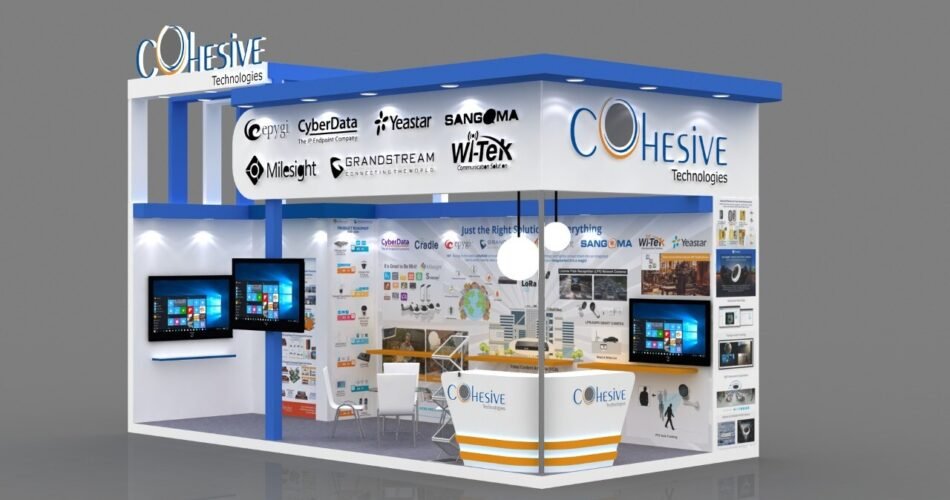Trade fairs have long been vital arenas for business networking, product launches, and industry trends. However, the idea of the traditional booth is experiencing a significant evolution. As technology becomes more deeply integrated into every aspect of event planning, smart stands are reshaping the future of trade fair participation. These intelligent exhibition booths are not just aesthetically advanced; they are designed to engage, analyze, and interact in ways that were unimaginable a decade ago.
In cities like Berlin—recognized globally for its thriving trade fair industry—this technological shift is especially evident. Companies seeking to remain competitive are turning to innovation-driven solutions. Collaborating with a skilled Exhibition Stand Builder in Berlin can now mean more than design expertise—it often includes integration of cutting-edge tools such as real-time analytics, touchless interaction, and augmented reality (AR).
Smart Stands: A Fusion of Technology and Engagement
Smart stands are exhibition spaces that integrate digital technologies to enhance visitor interaction, streamline operations, and provide real-time data. This technological evolution is transforming both the exhibitor’s experience and that of the attendees. Smart stands typically feature:
- Interactive Screens and Kiosks: These allow visitors to explore product ranges, watch demonstrations, or even personalize their experience through gamification or product configuration tools.
- Augmented and Virtual Reality: AR/VR technologies are now increasingly common in trade fair setups. They allow attendees to engage with virtual product demos or take immersive tours that would otherwise require physical prototypes or large-scale displays.
- Touchless Interfaces and IoT: Especially since the pandemic, touchless solutions such as motion sensors, facial recognition, and voice commands have gained traction. Integrated IoT devices further enable the monitoring of crowd flow and engagement patterns within the booth.
- AI-Driven Data Analytics: Exhibitors can now collect valuable data such as visitor demographics, time spent at booths, and product preferences. This data not only improves current performance but also provides insights for future events.
Sustainability and Smart Design
As technology advances, so does the awareness of sustainable design. Smart stands often emphasize energy efficiency, reusable components, and digital brochures to replace printed materials. LEDs, modular structures, and recyclable materials are becoming standard. These green practices align with the values of environmentally conscious businesses and attendees.
Moreover, digital integration reduces the need for excessive manpower. Automation, from visitor registration to digital product catalogs, allows brands to focus more on meaningful engagement and less on logistics. Sustainability is no longer an afterthought—it’s becoming a central element of stand design and execution.
5G, Cloud, and Real-Time Interaction
Emerging technologies such as 5G connectivity and cloud computing are enabling more seamless and efficient interaction within smart stands. With high-speed internet access, exhibitors can run cloud-based software, stream high-definition media, or even conduct live product demonstrations to remote audiences.
This connectivity also allows for real-time syncing of customer data with marketing tools, enabling sales representatives to provide personalized offerings or follow-ups instantly. It supports hybrid events as well, where physical attendees can interact with virtual participants through screens, avatars, or real-time chats.
Customization and Brand Storytelling
A key strength of smart stands is their ability to support personalized and immersive brand storytelling. Digital walls can adapt to display different brand messages depending on the visitor demographic or time of day. Facial recognition or RFID-enabled badges can be used to tailor the booth content to each visitor’s preferences.
Custom apps, gamified interactions, and AI-generated content make each booth experience unique. This level of personalization leads to better retention of brand messaging, higher visitor engagement, and more substantial post-event conversions.
Challenges and Future Outlook
Despite the promise of smart stands, challenges remain. Cost is a significant factor, especially for small and medium-sized exhibitors. Data privacy is another critical issue, as collecting and analyzing visitor information must be done in compliance with GDPR and other regulations.
However, as technologies become more affordable and widely available, smart stands are expected to become the norm. Exhibitors who embrace these changes early are likely to enjoy a competitive advantage, higher visitor retention, and improved return on investment (ROI).
Conclusion: A New Era for Trade Fair Participation
The integration of intelligent technologies into exhibition spaces is redefining how brands approach trade fairs. From real-time data tracking to immersive AR experiences, smart stands are driving deeper engagement and operational efficiency. For those exhibiting in Europe’s top trade hubs, these innovations are not just optional—they are essential.
As cities like Berlin continue to lead in hosting global industry events, the demand for innovation-oriented design partners grows. Working with an experienced Exhibition Stand Builder in Berlin offers companies a gateway to this new era of experiential marketing. These builders understand how to merge technology, creativity, and functionality into a single cohesive space that reflects brand identity.
Moreover, the broader trade fair ecosystem is being reshaped by these trends. Whether in Berlin, Munich, or beyond, the rise of the Exhibition Stand Builder in Germany market is a response to evolving exhibitor needs. By combining craftsmanship with smart tech, these builders are helping brands connect more deeply with audiences—and setting the tone for the future of global trade fairs.
